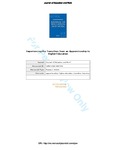Experiencing the transition from an apprenticeship to higher education
| dc.contributor.author | Dismore, Harriet | |
| dc.date.accessioned | 2017-11-27T15:54:39Z | |
| dc.date.available | 2017-11-27T15:54:39Z | |
| dc.date.issued | 2014-11-02 | |
| dc.identifier.issn | 1363-9080 | |
| dc.identifier.issn | 1469-9435 | |
| dc.identifier.uri | http://hdl.handle.net/10026.1/10299 | |
| dc.description.abstract |
It is the intention of the UK government to enhance progression routes for apprentices to higher education. However, little research has been carried out into why former apprentices pursue higher education or the experiences of this transition. This paper seeks to redress this gap by reporting three case studies of former apprentices who had completed or were completing a higher education qualification in England. Each case study represents a different route to higher education: progressing to a full-time higher education course; pursuing a part-time route to sustain full-time employment; and undertaking a career change during the transition to higher education. The paper addresses their experiences of the apprenticeship, the decision-making to progress and the perceived outcomes of their transition so far. Analysis draws on Fuller and Unwin’s expansive–restrictive framework and conceptual lenses for understanding learning. The findings revealed that although their apprenticeships were restrictive in different ways, progression was pursued for a number of reasons involving the context in which apprenticeships were completed, the relationship to their employer, the higher education context and their understanding of learning. Experiences of boundary crossing were particularly associated with more complex descriptions of personal transformation and learning as becoming. | |
| dc.format.extent | 585-607 | |
| dc.language | en | |
| dc.language.iso | en | |
| dc.publisher | Informa UK Limited | |
| dc.subject | 4 Quality Education | |
| dc.title | Experiencing the transition from an apprenticeship to higher education | |
| dc.type | journal-article | |
| dc.type | Journal Article | |
| plymouth.issue | 6 | |
| plymouth.volume | 27 | |
| plymouth.publication-status | Published | |
| plymouth.journal | Journal of Education and Work | |
| dc.identifier.doi | 10.1080/13639080.2013.802831 | |
| plymouth.organisational-group | /Plymouth | |
| plymouth.organisational-group | /Plymouth/Faculty of Arts, Humanities and Business | |
| plymouth.organisational-group | /Plymouth/Faculty of Arts, Humanities and Business/Plymouth Institute of Education | |
| plymouth.organisational-group | /Plymouth/REF 2021 Researchers by UoA | |
| plymouth.organisational-group | /Plymouth/REF 2021 Researchers by UoA/UoA23 Education | |
| plymouth.organisational-group | /Plymouth/Users by role | |
| plymouth.organisational-group | /Plymouth/Users by role/Academics | |
| dc.identifier.eissn | 1469-9435 | |
| dc.rights.embargoperiod | Not known | |
| rioxxterms.versionofrecord | 10.1080/13639080.2013.802831 | |
| rioxxterms.licenseref.uri | http://www.rioxx.net/licenses/all-rights-reserved | |
| rioxxterms.type | Journal Article/Review |


